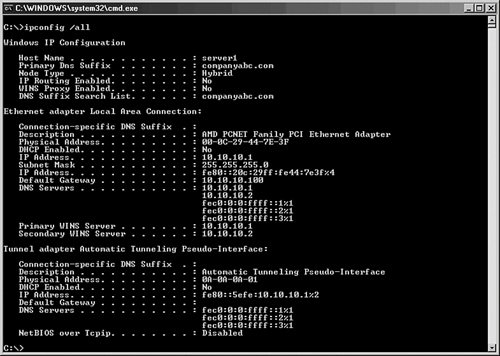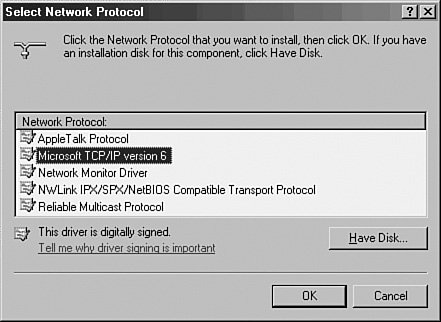Windows Server 2003 IPv6 Support
| When the original structure of the Internet was taking shape, an addressing scheme was formulated to scale to a large number of hosts. From this thinking came the original design of the Internet Protocol, which included support for 232 addresses. The thinking at the time was that this would be more than enough addresses for all hosts on the Internet. This original design gave birth to the IP address structure that is common today, known as dotted-decimal format (such as 12.155.166.151). At the time, this address space filled the addressing needs of the Internet. However, it was quickly discovered that the range of addresses was inadequate, and stopgap measures such as Network Address Translation (NAT) were required to make more efficient use of the available addresses. In addition to an inadequate supply of available addresses, the Internet Protocol version 4 (IPv4), as it is known, did not handle routing, IPSec, and QoS support very efficiently. The need for a replacement to IPv4 was evident. In the early '90s, a new version of the Internet Protocol, known as Internet Protocol version 6 (IPv6), was formulated. This design had several functional advantages to IPv4, namely a much larger pool of addresses from which to choose (2128). This protocol is the future of Internet addressing, and it's vitally important that an operating system support it. Windows Server 2003 comes with a version of IPv6 ready to install, and is fully supported as part of the operating system. Given the complexity of IPv6, it will undoubtedly take some time before it is adopted widely, but understanding that the support exists is the first step towards deploying it widely. Defining the Structure of IPv6To say that IPv6 is complicated is an understatement. Attempting to understand IPv4 has been difficult enough for network engineers; throw in hexadecimal 128-bit addresses and life becomes much more interesting. At a minimum, however, the basics of IPv6 must be understood as future networks will use the protocol more and more as time goes by. IPv6 was written to solve many of the problems that persist on the modern Internet today. The most notable areas that IPv6 improved upon are the following:
Understanding IPv6 AddressingAn IPv6 address, as previously mentioned, is 128-bits long, as compared to IPv4's 32-bit addresses. The address itself uses hexadecimal format to shorten the nonbinary written form. Take, for example, the following 128-bit IPv6 address written in binary: 111111101000000000000000000000000000000000000000000000000000000000000010000011 00001010011111111111111110010001000111111000111111 The first step in creating the nonbinary form of the address is to divide the number in 16-bit values: 1111111010000000 0000000000000000 0000000000000000 0000000000000000 0000001000001100 0010100111111111 1111111001000100 0111111000111111 Each 16-bit value is then converted to hexadecimal format to produce the IPv6 address: FE80:0000:0000:0000:020C:29FF:FE44:7E3F Luckily, the authors of IPv6 included ways of writing IPv6 addresses in shorthand by allowing for the removal of zero values that come before other values. For example, in the address listed previously, the 020C value becomes simply 20C when abbreviated. In addition to this form of shorthand, IPv6 allows continuous fields of zeros to be abbreviated by using a double colon. This can only occur once in an address, but can greatly simplify the overall address. The example used previously then becomes: FE80:::20C:29FF:FE44:7E3F Note It's futile to attempt to memorize IPv6 addresses, and converting hexadecimal to decimal format is often best accomplished via a calculator for most people. This has proven to be one of the disadvantages of IPv6 addressing for many administrators. IPv6 addresses operate much in the same way as IPv4 addresses, with the larger network nodes indicated by the first string of values and the individual interfaces illustrated by the numbers on the right. By following the same principles as IPv4, a better understanding of IPv6 can be achieved. Installing IPv6Windows Server 2003 contains built-in support for IPv6, although it is not installed by default. Installation can take place through the command prompt by simply typing the following command: Netsh interface ipv6 install Support can also be added via the Network Components GUI interface by following these steps:
Once installed, the IPv6 address will be configured in addition to the IPv4 address. To display both sets of addresses, type ipconfig /all at the command prompt, as illustrated in Figure 7.18. Figure 7.18. Viewing IPv4 and IPv6 addresses. Migrating to IPv6The migration to IPv6 has been, and will continue to be, a slow and gradual process. In addition, support for IPv4 during and after a migration must still be considered for a considerable period of time. It is consequently important to understand the tools and techniques available to maintain both IPv4 and IPv6 infrastructure in place during a migration process. When IPv6 is installed on Windows Server 2003, IPv4 support remains by default. This allows for a period of time in which both protocols are supported. Once migrated completely to IPv6, however, connectivity to IPv4 nodes that exist outside of the network (on the Internet, for example) must still be maintained. This support can be accomplished through the deployment of IPv6 tunneling technologies. Windows Server 2003 tunneling technology consists of two separate technologies. The first technology, the Intrasite Automatic Tunnel Addressing Protocol (ISATAP), allows for intrasite tunnels to be created between pools of IPv6 connectivity internally in an organization. The second technology is known as 6to4, which provides for automatic intersite tunnels between IPv6 nodes on disparate networks, such as across the Internet. Deploying one or both of these technologies is a must in the initial stages of IPv6 industry adoption. Making the Leap to IPv6Understanding a new protocol implementation is not at the top of most people's wish lists. In many cases, improvements such as improved routing, support for IPSec, no NAT requirements, and the like, are not enough to convince organizations to make the change. The process of change is inevitable, however, as the number of available nodes on the IPv4 model decreases. Consequently, it's good to know that Windows Server 2003 is well prepared for the eventual adoption of IPv6. |
EAN: 2147483647
Pages: 499
- Success Story #1 Lockheed Martin Creating a New Legacy
- Seeing Services Through Your Customers Eyes-Becoming a customer-centered organization
- Success Story #4 Stanford Hospital and Clinics At the forefront of the quality revolution
- Using DMAIC to Improve Service Processes
- Designing World-Class Services (Design for Lean Six Sigma)
